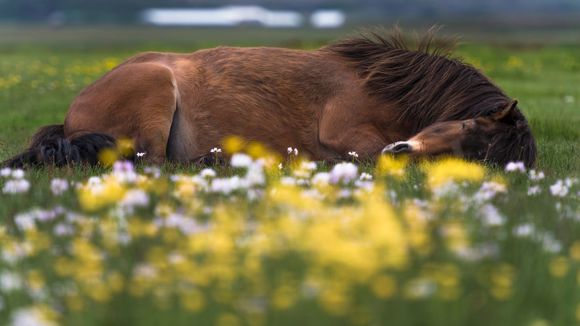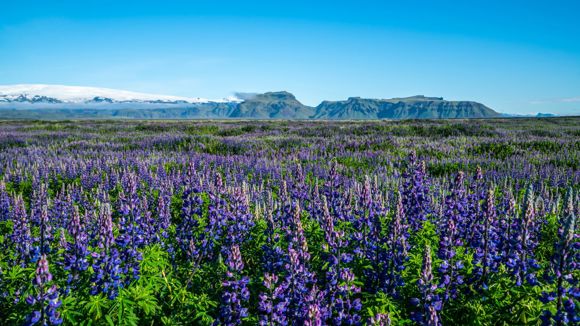Your Guide to Visiting Iceland in Spring

Spring in Iceland sees the country emerge from hibernation and transform into a brighter time. There might still be snow scattered across the landscape, but the weather will become more mild. The days lengthen, while puffins and whales return to the shores of the capital. Keep reading to discover why you should visit Iceland in Spring.
When is Spring in Iceland?
Spring in Iceland begins in March and reaches its peak in April and May. There was, however, a time when Icelanders did not recognise spring at all! According to the old Norse calendar, there were only two seasons: summer and winter, each six months long.
The season begins once the snow starts melting as the temperatures rise. The change is quite noticeable as there’s more greenery and wildlife around. And for Icelanders, spring doesn’t start until the arrival of the Golden Plover. These birds arrive as early as late March in South Iceland, marking the traditional start to spring season.

Best Things to Do in Iceland in Spring
Longer days and warm weather mean there are plenty of things to do in Iceland in spring. Here are some of the best:
1. Watch the Wildlife Season Kick-off
The wildlife season in Iceland officially kicks off in spring. Whether you want to go whale-watching or spot Arctic foxes, or puffins along the coast, April and May are the perfect time to do it. If you weren’t aware of it already, Dyrhólaey on the south coast is the favourite ocean cliffs of puffins if you’re looking at boat tours.
2. Go on a Self-Drive Tour
Unlike winter, Iceland’s roads are in excellent condition in spring, making it the perfect time to go on a self-drive tour. You can escape the crowds and drive along Iceland’s highways as you explore the country at your own pace. From popular attractions to hidden gems in remote locations, you’ll have the freedom to chart your way on the road.
3. Tour the Golden Circle
The Golden Circle in South Iceland is, by far, one of the most popular tours in Iceland, meaning it’s also crowded. But spring sees the least amount of visitors in Iceland. So you’ll be able to explore the country’s most sought-after attractions such as the Gullfoss waterfall, Þingvellir National Park, and the Geysir geothermal area with fewer people.
4. Hike the Mountains of Iceland
Hiking is one of the best ways to experience Iceland in spring. The trails are in excellent condition and there are lupine flowers everywhere making the landscapes breathtakingly beautiful. You’ll also spot baby sheep from May onwards so it’ll be a paradise for Nature lovers.
5. Catch the Northern Lights
The Northern Lights phenomenon requires dark, clear skies. With the right solar activity, you can catch it outside of Winter if you’re lucky. In Reykjavík, sunset is between 8 p.m. to 10 p.m. in April. If the Aurora Borealis is the focus of your springtime trip in Iceland, you’ll have the best chance of viewing them till mid-April. The colourful lights shining upon the blooming lupine fields make it a magical experience.

Why Should You Visit Iceland in Spring?
If you’re struggling to make up your mind about visiting Iceland in spring, here are some factors you should consider.
-
The number of visitors to Iceland is lower during spring. This means you’ll have its stunning landscapes all to yourself making your trip a getaway like no other.
-
As it’s not peak season, travel prices are considerably cheaper in spring making it the best time of year for a budget holiday.
-
Spring is also ideal for outdoor adventures as you’ll have more daylight and warmer weather.
-
The natural light during spring, especially during May, is ideal for photography. The quality of the light is particularly striking during sunset and sunrise.
Weather Conditions in Iceland in Spring
During spring, Iceland enjoys mild weather as the winter storms are finally over. Precipitation is lowest in May and June, which makes late spring the ideal time for hiking in Iceland. At the same time, however, Iceland’s weather can be quite unpredictable. So you should be prepared for wind, and snow (especially if you’re in the North or the Highlands).

What to Pack For Iceland in Spring
You should pack warm, waterproof clothing when visiting Iceland in spring, even though the weather is typically mild and dry this time of year. There can be some occasional showers of rain and snow, so it’s best to be prepared. These essentials should suffice:
-
Warm and Waterproof Layers: Pack warm clothes that you can layer up or down as needed. A thermal vest, a warm sweater, and a waterproof jacket are the three main things you should pack.
-
Waterproof Shoes: In addition to your clothes, your shoes should be waterproof, especially when it’s wet outside. Hiking boots are ideal for Iceland’s uneven terrain. Plus, they’ll keep your feet warm.
-
Accessories: A warm hat, gloves, and a scarf are the main accessories you’ll need in Iceland in spring. Additionally, you should also pack sunglasses, as the sunlight gets quite intense in spring.
-
Swimwear: If visiting hot springs and lagoons is on your itinerary, don’t forget to pack some swimwear. Plus, they’re handy to have when you want a relaxing Icelandic spa experience after a long day spent outdoors.
-
Electronics: Your backpack isn’t complete without a camera to capture all those fantastic springtime views in Iceland. Don’t forget to pack chargers and adapters to keep them running.

Spring in Iceland is truly magical. You get to explore the green landscapes and spot birds and wildlife in the sun. There are also fewer visitors around this time and tour prices are relatively cheaper. If you’d like to experience Iceland in spring, start your journey today by booking a stay at one of Iceland’s top hotels.